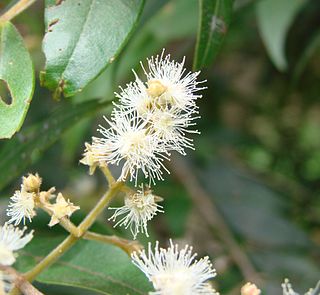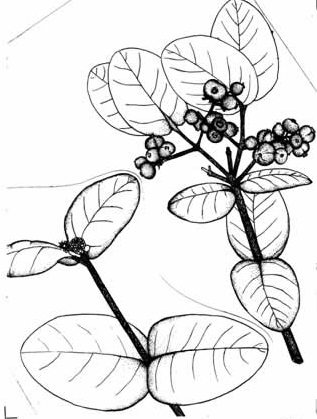
Myrtaceae, the myrtle family, is a family of dicotyledonous plants placed within the order Myrtales. Myrtle, pōhutukawa, bay rum tree, clove, guava, acca (feijoa), allspice, and eucalyptus are some notable members of this group. All species are woody, contain essential oils, and have flower parts in multiples of four or five. The leaves are evergreen, alternate to mostly opposite, simple, and usually entire. The flowers have a base number of five petals, though in several genera, the petals are minute or absent. The stamens are usually very conspicuous, brightly coloured, and numerous.

Myrcia is a genus of plants in the family Myrtaceae, containing about 765 species as of 2022. They are distributed in Central and South America, Mexico, and the Caribbean, with centers of diversity in the Brazilian Cerrado and Atlantic Forests ecoregions. Myrcia was first described as a genus in 1827.
Myrcia neothomasiana, commonly known as Thomas' lidflower, is a rare species of plant in the family Myrtaceae. It is found on three Caribbean islands. There are fewer than 250 individuals total divided amongst the islands of Vieques in Puerto Rico, St. John in the United States Virgin Islands, and Virgin Gorda in the British Virgin Islands. It has been extirpated from the wild on Saint Thomas, U.S. Virgin Islands, where it was first described in 1855, and now only grows there in cultivation.

Myrcia sintenisiana is a species of flowering plant in the family Myrtaceae. It is endemic to Puerto Rico, where it is limited to the Luquillo Mountains. It occurs in El Yunque National Forest in dwarf forest habitat on wet mountain ridges. Its common name is beruquillo.

Nepenthes micramphora is a tropical pitcher plant known only from Mount Hamiguitan on the island of Mindanao in the Philippines. It is a highland plant growing at elevations of 1100–1635 m.
Balanophora coralliformis, sometimes known as coral plant, is a flowering plant in the family Balanophoraceae and is known only from Mount Mingan on the island of Luzon in the Philippines. Like others in its genus, it is an obligate parasite growing on the roots of rainforest trees, but differs in that its tuber appears above ground and has an elongated, repeatedly branched, coral-like structure. It was first described in 2014 and is known from fewer than 50 plants, but has not as yet been declared endangered.

Myrcia guianensis (pedra-ume-caá) is a species of plant in the genus Myrcia of the family Myrtaceae native to South America.

Myrciaria glazioviana, the cabeluda, or yellow jaboticaba, is a species of plant in the family Myrtaceae.
Myrcia crassa is a species of plant in the family Myrtaceae. It is endemic to the municipality of Santa Teresa, Espírito Santo, Brazil, where its habitat is fragmented and declining due to deforestation. The tree was first described in 2010 and grows to between 1.5 and 18 metres tall.
Myrcia floridissima is a species of plant in the family Myrtaceae. It is endemic to the atlantic rainforest of eastern Minas Gerais, Brazil, where its habitat is fragmented and declining due to deforestation. The tree was first described in 2010 and grows up to 6 metres tall.
Myrcia mucugensis is a species of plant in the family Myrtaceae. It is endemic to Campos rupestres habitats in central Bahia, Brazil, 800 to 1000 metres above sea level. The shrub was first described in 2010 and grows to between 1.5 and 2 metres tall, with 2mm diameter fruits.
Myrcia pendula is a species of plant in the family Myrtaceae. It is endemic to rainforest habitats in south-east Bahia, Brazil, at 600 to 700 metres above sea level. The tree was first described in 2010 and grows to between 3 and 15 metres tall.
Myrcia tetraphylla is a species of plant in the family Myrtaceae. It is endemic to coastal rainforest habitats in southern Bahia, Brazil. The tree was first described in 2010, grows to between 2 and 8 metres tall, and produces purple fruits between 15 and 22mm in diameter.
Plinia rivularis, commonly known as yva poroity, jaboticabarana, jabúriti, guapuriti, cambucá peixoto, jabuticaba de cacho, or piuna is a species of plant in the family Myrtaceae.
Myrciaria cambuca, named after its common name cambucá, is a species of plant in the family Myrtaceae. First described in 2019, it is a small shrub with reddish fruit, and was previously misidentified as Myrciaria ferruginea.
Myrcia ascendens is a species of plant in the family Myrtaceae, endemic to Bahia in north-east Brazil, and first described in 2015.
Myrcia attenuata is a species of plant in the family Myrtaceae, endemic to French Guiana, and first described in 2015.
Myrcia rupestris is a species of plant in the family Myrtaceae, endemic to south-east Brazil, and first described in 2015.
Myrcia subterminalis is a species of plant in the family Myrtaceae, endemic to the east of Brazil, and first described in 2015.
Metrosideros tabwemasanaensis is species of plant in the family Myrtaceae. It is a tree endemic to Mount Tabwemasana on the island of Espiritu Santo in Vanuatu.





